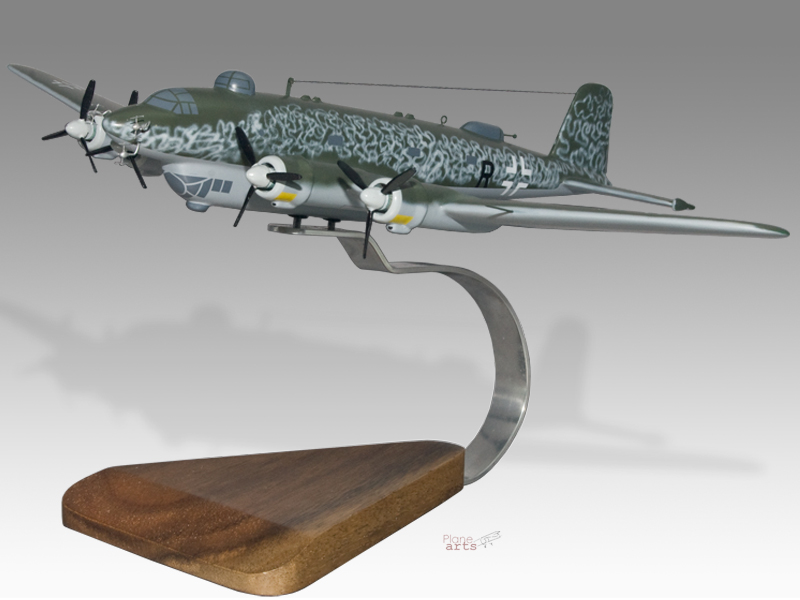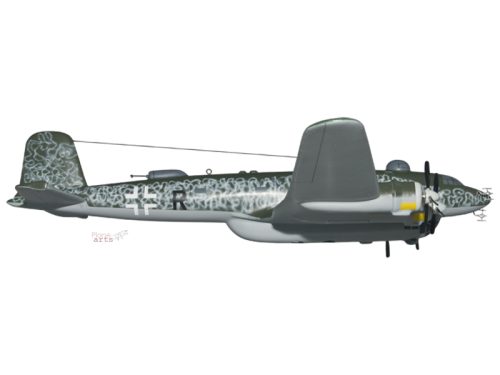Focke Wulf FW 200 Condor
Production Time 9 to 10 weeks
Shipment is by FedEx, UPS or DHL International Express Courier with a normal door-to-door delivery time worldwide of within 2-3 business days after dispatch. Due to the current volatility of world fuel prices, the amount mentioned here is our best estimate for DHL and UPS and may be subject to change at the time of shipping.

Model Description: Focke Wulf FW 200 Condor Wood Replica Scale Custom Model Aircraft
Manufacturer: Focke-Wulf
Wingspan: 17 Inches (43.2 Centimeters)
Height: 3.25 Inches (8.3 Centimeters)
Scale: 1:76
$249.50
Production Time 9 to 10 weeks
-
United States dollar ($)
-
Pound sterling (£)
-
Euro (€)
-
Australian dollar ($)
-
Canadian dollar ($)
-
Singapore dollar ($)
-
Swiss franc (CHF)
-
Japanese yen (¥)
-
Danish krone (kr.)
-
Hong Kong dollar ($)
-
Norwegian krone (kr)
-
Swedish krona (kr)
-
United Arab Emirates dirham (د.إ)
General Product Description
Our PlaneArts Focke Wulf FW 200 Condor model exhibits unique, unrivaled quality and detailed design to come as close as possible to the accuracy of the actual plane. It comes as standard with a robust, durable base or stand which is available in a variety of different finishes designed to match your own personal requirements including solid wood, wood with polished metal supports or adjustable wood wall mount and will be ready within about 9-10 weeks from placement of order.
The Focke Wulf FW 200 Condor model is made of the finest kiln dried renewable mahogany wood (commonly known as Lauan or Meranti) which has undergone many stages of carving and meticulous and careful sanding giving the beautiful, finished museum quality masterpiece. Many collectors and model connoisseurs demonstrate their preference for genuine handmade and hand painted mahogany wood models rather than plastic or die cast (diecast) alternatives due to the overall look and totally different feel of the item - we trust you will find the same. We can however, if required produce the same model in Solid Cast Resin so just click and contact us for further information. Our craftsmen and gifted artisans ensure that our finely handcrafted model airplanes match the precise blueprint details of the original aircraft. The paint scheme, markings and parts are closely matched, reflecting the original aircraft. This stylish top-quality desktop replica model will surely enthrall anyone who receives this as a gift and for sure one of the most appropriate and desirably collectable gifts for any military aviation enthusiast and avid aircraft collector whilst also displaying a perfect resemblance to the actual real life version.
There are many types of military propeller aircraft, but the basic types are bombers, fighters, fighter bombers, spotter planes, transporters, patrol aircraft, trainers, and reconnaissance and observation aircraft. All these types of aircraft are used for different types of missions. If you're a fan of historic or present-day military aviation, our model aircraft will bring the excitement and character of these aircraft right into your own home. You can order a wood airplane model of a North American B-25 Mitchell Bomber, a B17 - Flying Fortress, or a P-51 Mustang Nervous Energy V not forgetting the Bf 109, Spitfire, FW 190, A6M Zero, P-38 and F4U. These classic, propeller airplane models are of the highest quality. Each is individually crafted by our expert craftsmen. They produce handmade scale mahogany airplane models of the finest aircraft from World War I and II to present day biplanes and triplanes.
If you require, we can also make the Focke Wulf FW 200 Condor model in any other military, government or even private livery or colour scheme you require and if necessary, in a different size or scale. Just click here to contact us with a description or photographs of what you require, and we will let you have a quotation for the necessary customization by return email. We can also make bespoke scale replicas of any other private / civil commercial airliner or airliners, helicopter, glider, gliders with engines, military jet, warplane jets, biplane, triplane, tail fin, spacecraft, rocket or NASA model you require in any airline, military or civilian livery or colors. We also produce model airships, blimps, dirigibles, blimps, boats, and ship collectibles. Wall plaque or seal for military, government or private customers. Again, by clicking here to contact us just let us know exactly what you need.
Focke-Wulf FW 200 Condor
The Focke-Wulf FW 200 Condor, a German aircraft designed in the late 1930s by Kurt Tank, stands as a remarkable example of aviation engineering from the World War II era. Originally conceived as an airliner for Lufthansa, the aircraft was quickly adapted for use in long-range reconnaissance and maritime patrol missions by the Luftwaffe. This article explores the features, advantages, and benefits of the FW 200 Condor, illuminating why it became an iconic aircraft of its time.
Features of the Focke-Wulf FW 200 Condor:
- Design and Construction: The FW 200 featured a low-wing monoplane design primarily made from metal, with fabric-covered flight control surfaces. It was notable for its broad, 32-meter wingspan which facilitated long-range flight.
- Powerplant: The aircraft was powered by four radial engines, which varied in model throughout its service but typically included BMW 132 or Bramo 323 Fafnir engines. This configuration provided a robust power output that was essential for its transatlantic capabilities.
- Range and Capacity: As an airliner, the Condor could accommodate up to 26 passengers and had a maximum range of approximately 3,000 kilometers. In its military configuration, it could carry a substantial payload of bombs and was equipped with multiple machine gun positions for defense.
- Avionics and Equipment: For its time, the FW 200 was equipped with advanced navigation and radio equipment, which was crucial for its role in long-range maritime patrol and reconnaissance missions over the Atlantic.
Advantages of the Focke-Wulf FW 200 Condor:
- Versatility: The FW 200’s design allowed for multiple roles, including commercial air travel, military transport, reconnaissance, and as a bomber. This versatility made it a valuable asset for the Luftwaffe during the war.
- Long-Range Capabilities: One of the primary advantages of the FW 200 was its ability to conduct operations far from home bases, particularly in the vast Atlantic region. This capability was instrumental in allowing Germany to perform reconnaissance and engage Allied shipping routes.
- Innovative Technologies: The incorporation of advanced avionics and navigation systems enabled the Condor to perform complex over-water navigation tasks more effectively than many of its contemporaries.
Benefits of the Focke-Wulf FW 200 Condor:
- Strategic Impact: The Condor significantly impacted wartime strategies by providing the German military with a means to scout and disrupt Allied shipping lanes. Its ability to detect and shadow convoys from a distance without engaging allowed for effective coordination of U-boat attacks.
- Economic Use: Outside of its military application, the FW 200 demonstrated the potential for commercial air travel across the Atlantic, showcasing how aircraft could shrink global travel times and contribute to international business and communication.
- Technological Benchmark: The development and operational success of the FW 200 spurred advancements in aircraft design, particularly in the areas of long-range flight and payload capacity. It set a benchmark for future multi-engine aircraft.
Conclusion:
The Focke-Wulf FW 200 Condor was more than just an aircraft; it was a symbol of technological advancement and strategic capability. Its design and multifunctional roles not only served Germany during World War II but also influenced post-war aviation development. The Condor remains a significant study subject for those interested in the history of aviation and military strategy, illustrating the complex interplay between technology and warfare.
| Weight | 6 kg |
|---|---|
| Dimensions | 12.1 × 17 × 3.25 in |











Reviews
There are no reviews yet.